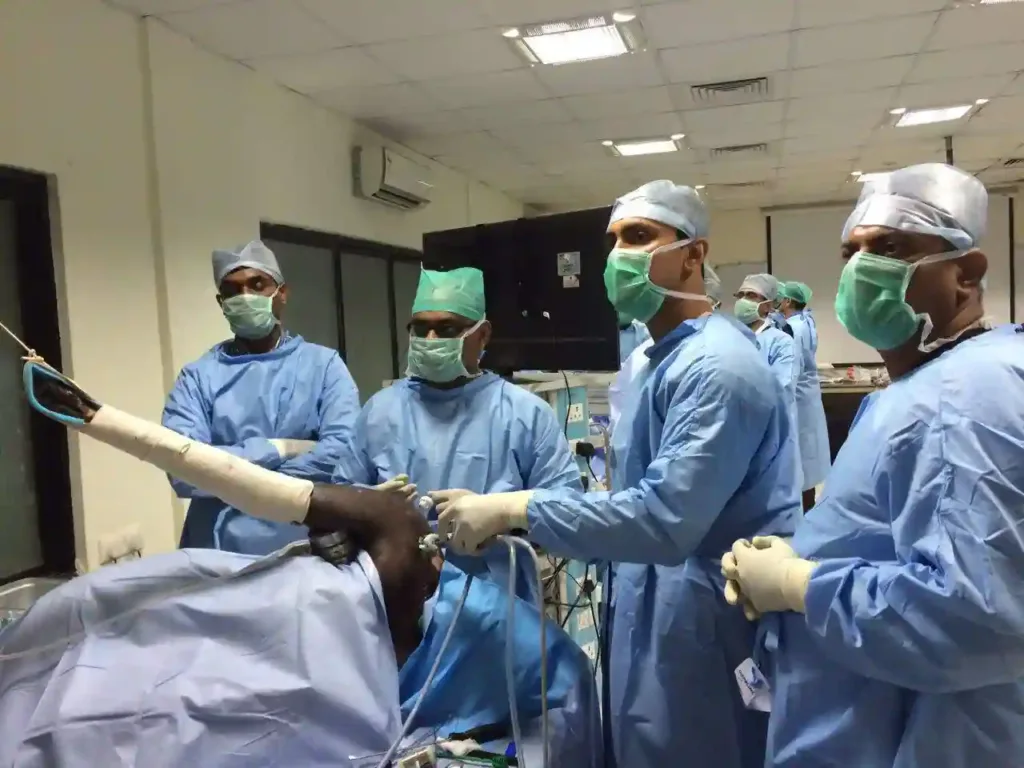Arthroscopy in Pune - Dr. Yash Shah
Arthroscopy is a procedure to diagnose and treat joint problems. Through a tiny incision the size of a buttonhole, a surgeon inserts a slender tube attached to a fiber-optic video camera. The view inside the joint is transmitted to a high-definition video monitor.Dr. Yash Shah is a dedicated orthopaedic surgeon. he Perfomed Arthroscopy in Pune Since last 11 Years .
Arthroscopy is a surgical procedure that doctors use to examine, diagnose, and treat problems within a joint. This is a small procedure that is performed as an outpatient, which means you may go home the same day. If you have joint inflammation, have been wounded, or have damaged a joint over time, your doctor may advise you to try it.


Arthroscopy can be performed on any joint. Most often it is performed on the knee, shoulder, elbow, ankle, hip, or wrist.
During the surgery, the doctor inserts an arthroscope into the joint through many tiny slits to assess the amount of the joint’s injury. During arthroscopy, they can also repair a variety of injuries.
Preparing for Arthroscopy Before having an arthroscopy or any other procedure, be sure to tell your doctor about any medications or vitamins you are taking. All jewellery, watches, and some other valuables should be left at home.Put on and take off.
The day before the arthroscopy, do not eat or drink anything unless your doctor tells you otherwise. Even before surgery, your doctor will offer you soapy sponges to massage your elbow or shoulder with so that someone may drive you home afterwards. home later.
What Happens During the Procedure?
Your doctor can perform arthroscopic surgery in a very hospital or patient in operation room. The type of anaesthetic you’ll receive is determined by the joint and what your doctor believes is the source of the problem. it’s going to be general anaesthesia (you’ll be asleep throughout surgery), or your doctor will provides it to you thru your spine. they could conjointly numb the world they’re doing the surgery on.
Your doctor will insert special pencil-thin instruments through atiny low cut (incision) the scale of a buttonhole. The endoscope tool they use contains a optical lens and a light. It permits them to see within the joint. The camera comes a picture of the joint onto a screen. The doctor can fill the joint with sterile fluid to widen it thus it’s easier to see.
They’ll look inside the joint, diagnose the problem, and choose what form of surgery you would like, if any. If you are doing need surgery, your surgeon will insert special tools through alternative tiny incisions referred to as portals. They’ll slashed, shave, capture, and anchor stitches into bone with them. If your surgeon decides you need traditional, “open” surgery to repair the problem, they’ll get laid at the same time as your arthroscopic surgery. later , they’ll take away the endoscope and any attachments. They’ll shut the wound with special tape or stitches.
What About Recovery?
When the surgical process is over, you’ll be taken to a hospital room wherever you’ll rest for regarding AN hour or more. you will have some pain within the joint once surgery. Your doctor may inflict pain medication and exercise. they could conjointly prescribe analgesic or different medication to stop blood clots. Apply ice for the primary twenty four hours to scale back swelling. If you’ve had an arthroscopy on your knee, elevate the leg to reduce pain. Take pain medicines as prescribed, and don’t drink alcohol. you will would like crutches, a splint, or a sling for support as you recover.
Arthroscopic surgery sometimes ends up in less joint pain and stiffness than open surgery. Recovery conjointly usually takes less time. You’ll have little puncture wounds wherever the arthroscopic tools move into your body. The day once surgery, you {will} be able to take away the surgical bandages and replace them with small strips to hide the incisions. Your doctor will remove non-dissolvable stitches after every week or 2.
whereas your wounds heal, you’ll need to keep the location as dry as possible. this suggests covering them with a bag after you shower. Your doctor will tell you what activities to avoid after you go home. you’ll typically return to figure or college inside some days of surgery. Full joint recovery typically takes many weeks. it’s going to take several months to induce back to normal. Rehabilitation or specific exercises can facilitate speed your recovery. Your doctor can tell you which of them ones are safe to do.
Benefits of arthroscopy
- Smaller incisions:- In Atrhoscopy Small incision are Made .
- Minimal soft tissue trauma.
- Less post-operative pain.
- Faster healing time.
- Lower infection rate.
Disadvantages of arthroscopy
Patient Complications
like several alternative procedure, there are risks concerned for the patient like blood clots, injury and infection within the knee joint, injury or injury to the nerves of the knee, blood vessels, and ligaments.
Improper Post-Op Care
though doctors provide directions for patients to follow reception throughout the recovery process, things will fail afterward. Since the patient won’t be at the hospital during the recovery, any damage is also caused to the knee.

